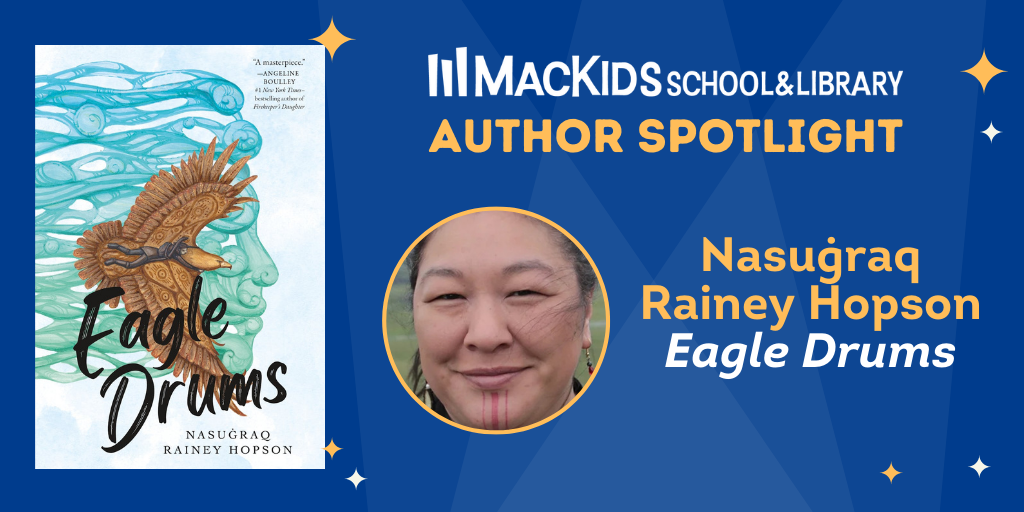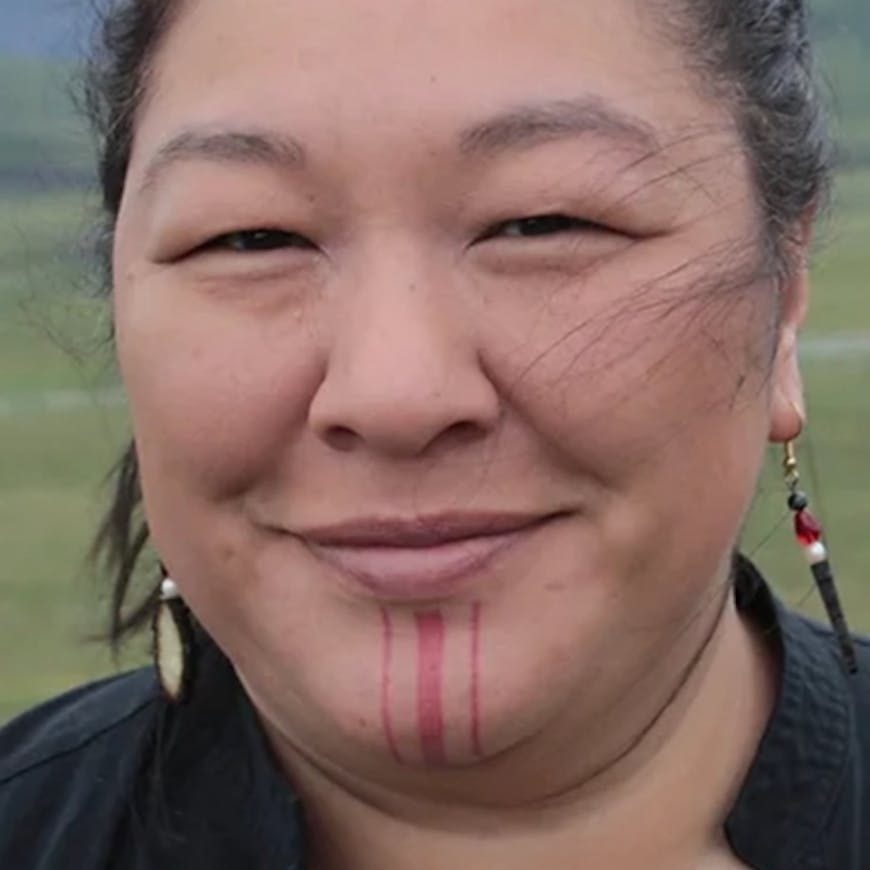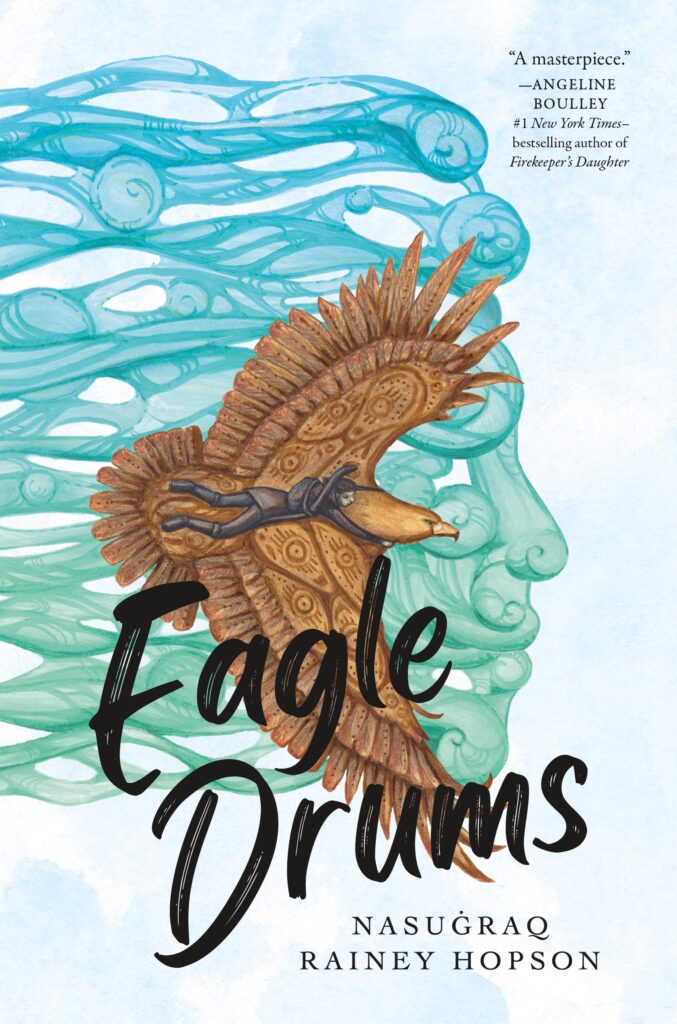
This month’s Author Spotlight highlights Nasuġraq Rainey Hopson, the author of Eagle Drums, a magical realistic middle grade debut about the origin story of the Iñupiaq Messenger Feast, a Native Alaskan tradition.
Can you tell us what inspired you to write Eagle Drums?
I was inspired to write Eagle Drums when an Elder told me of the story of the origins of the Messenger Feast. I was attending the gathering for the first time, and was already in love with and entranced by the experience of it all. When I heard the story, I was instantly fascinated by the drama and the overall message of the myth. Later, I wondered to myself what an oral story like that would look like as a written book. And I couldn’t help but to give it a try.
Tell us a little about what it was like to work on a middle grade debut novel.
Was the writing process different from writing short stories?
Writing short stories is all about celebrating the brevity of it all. And as an oral story, Eagle Drums was maybe around two pages written out. The challenge is to fulfill all your promises to your reader in a few pages, or a few minutes. Every word counts. When writing Eagle Drums, I found the challenge had shifted. Instead of being picky about what was included, I found that the opposite was true. I worked hard at adding just the right number of pages, so that the journey was all the sweeter because of the depth of experience. I learned a lot working with my editor on where to expand the story, to elicit the most impact.
What was your favorite part of writing this story or the publishing process as a
whole?
My absolute favorite part is finding others that enjoy this book as much as I do! I still find so much joy in the story and get emotional every time I read it, and having that connection of a shared experience with someone is so wonderful. Especially when it comes to children reading the book. Everything I write, I write for a younger version of myself—they are all love letters to my childhood. And their joy is my joy.
The imagery of food in this book is so vivid. It really makes your mouth water!
Can you share with our readers how important food is in this story?
Food is a central aspect of our culture; it is a love language in many different ways. There is no greater connection than through enjoying a good meal! Food acts as a
means of connection, and in the book, food is used to give the reader a sense of time as different things become available or unavailable for Piŋa to eat. Food is also a way that his family can connect with all of the first attendees of the first feast, to show goodwill and good intentions.
How do you hope this book will be used in classrooms and libraries?
I hope this book will be used to introduce the diversity of Native America. That there are hundreds of separate Tribes in the United States and that each and every one of the Tribes have a unique Library of stories and cultural dimensions. And I hope that it is used as a starting point to explore our modern Iñupiaq culture.
Tell us about a library, librarian, or educator who made an impact on you as a
child (or as an adult!).
All of our rural villages here each have a very small school library, and I have always
had a connection to ours during all of the stages of my childhood. When I was little, my Father would visit the library with us every week where he would pick about five books and my brother and I got to pick one by ourselves. He would read to us every single night before bed. We made it through the whole entire picture book section of the library two and a half times before we were old enough to graduate to reading books on our own. I have such fond memories of that library.
What advice would you give to aspiring writers?
Always keep writing! Whether or not you show others your writing does not matter. Whether it’s handwritten on paper or files on a computer, it doesn’t matter. Writing is one of those things that you get better at the more you do, and at the very least, it will build your confidence in yourself. Find joy in the process and get to know what writing looks like for you!
What was your favorite book when you were a young reader?
This is a hard question to answer! Because there are so many books that come to
mind. I have always been a huge fan of Science Fiction and Fantasy, and I remember Anne McCaffery’s Dragonriders of Pern series having an impact on me as well as Hitchhikers Guide to the Galaxy. As a child, there weren’t any books featuring my own culture or people like me, so the closest thing was being someone encountering an alien world.
ABOUT THE AUTHOR
ABOUT THE AUTHOR:

Nasuġraq Rainey Hopson was born and raised in the rural expanse of the North Slope of Alaska. She grew up on fantastic tales from her unique and rich Indigenous Iñupiaq culture. When she is not writing or creating art inspired by these stories, she is studying how to grow food in the arctic and is working at preserving traditional Iñupiaq knowledge. She has a degree in Studio Art and has taught all levels of Art from kindergarten to college level. She lives in Anaktuvuk Pass Alaska with her husband and daughter, three dogs, and a small flock of arctic chickens, where she lives off the land and the amazing bounty it provides like her ancestors did for thousands of years. She is the author of Eagle Drums.
ABOUT THE BOOK:
Eagle Drums
On Sale Now!
Ages 8-12
A magical realistic middle grade debut about the origin story of the Iñupiaq Messenger Feast, a Native Alaskan tradition.
As his family prepares for winter, a young, skilled hunter must travel up the mountain to collect obsidian for knapping—the same mountain where his two older brothers died.
When he reaches the mountaintop, he is immediately confronted by a terrifying eagle god named Savik. Savik gives the boy a choice: follow me or die like your brothers.
What comes next is a harrowing journey to the home of the eagle gods and unexpected lessons on the natural world, the past that shapes us, and the community that binds us.
Eagle Drums by Nasuġraq Rainey Hopson is part cultural folklore, part origin myth about the Messenger’s Feast—which is still celebrated in times of bounty among the Iñupiaq. It’s the story of how Iñupiaq people were given the gift of music, song, dance, community, and everlasting tradition.



